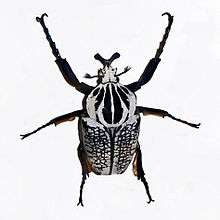Goliathus orientalis
| Goliathus orientalis | |
|---|---|
 | |
| Male of Goliathus orientalis. Mounted specimen on display at the Museo Civico di Storia Naturale di Milano | |
| Scientific classification | |
| Kingdom: | Animalia |
| Phylum: | Arthropoda |
| Class: | Insecta |
| Order: | Coleoptera |
| Family: | Scarabaeidae |
| Subfamily: | Cetoniinae |
| Genus: | Goliathus |
| Species: | G. orientalis |
| Binomial name | |
| Goliathus orientalis Moser, 1909 | |
| Synonyms | |
| |
Goliathus orientalis is a species of beetles belonging to the family Scarabaeidae.
Subspecies
- G. orientalis meleagris Sjöstedt, 1927
- G. orientalis orientalis Moser, 1909
Description
Goliathus orientalis is one of the largest species of the genus Goliathus, with a body length of about 50–100 millimetres (2.0–3.9 in) in males,[2] of about 50–65 millimetres (2.0–2.6 in) in females.[2][3]
The body is broad and flat. Elytra are whitish with a complex pattern of black markings usually in the form of black rings. Pronotum (thoracic shield) usually shows large black longitudinal stripes or a large black area. This usual pattern may differ greatly in the subspecies. The head bears a black Y-shaped horn in males, used in battles with other males. Legs are long, powerful, black. Despite its large body, these beetles fly well. They have a large and membranous secondary pair of wings. When not in use, these wings are kept completely folded beneath the elytra. These beetles feed primarily on tree sap and fruits.[4]
Life cycle
The larvae live in the soil and need a protein-rich diet, because they grow very quickly. In captivity they may be fed on commercial cat and dog food.[5] Even under optimum conditions, the larvae take about 4 months to mature fully, which corresponds to the duration of the rainy season. Larvae can reach a length of about 130 millimetres (5.1 in) and a weight of about 100 grams (3.5 oz).[5] When maximum size is reached, the larva constructs a pupal chamber in which it will undergo metamorphosis to the adult state. In this stage they spend most of the dry season. The adult does not come up before the rain comes. In captivity the adults can live over a year, but in the wild life is probably much shorter.[1][5]
Distribution and habitat
This species is present in the Democratic Republic of the Congo and in Tanzania.[1] It can be found in the savannah, in shady areas with trees.[2]
Gallery
.png) Male, spread wings
Male, spread wings Goliathus orientalis meleagris
Goliathus orientalis meleagris
References
- 1 2 3 4 Biolib
- 1 2 3 Natural World
- ↑ Beetles Space
- ↑ Jonathan R. Mawdsleya Taxonomy of the Goliath beetle Goliathus orientalis Moser, 1909 (Coleoptera: Scarabaeidae: Cetoniinae) Journal of Natural History, Volume 47, Issue 21-22, 2013
- 1 2 3 Karl Meier Goliathus Breeding Manual
| Wikispecies has information related to: Goliathus orientalis |
| Wikimedia Commons has media related to Goliathus orientalis. |